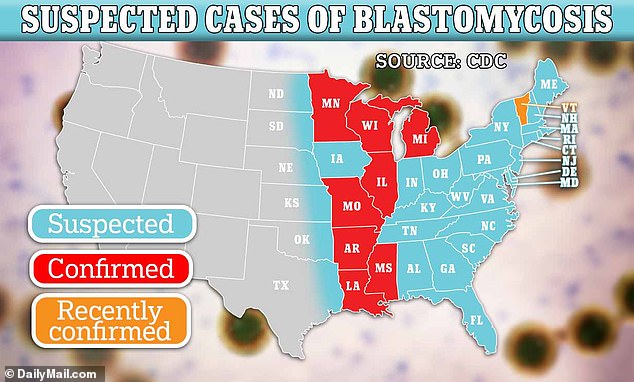Health officials are warning of a little-known deadly fungus that caused the largest fungal outbreak in U.S. history.
Last February, 162 Billerud Paper workers in Michigan fell ill with blastomycosis, an infection contracted by inhaling spores of the Blastomyces fungus.
Of those, 18 workers were hospitalized with scarring on their lungs that made it difficult for them to breathe. One patient died.
The outbreak made headlines at the time, but the CDC released its full report this week.
All patients worked or visited the factory and most reported apparently benign symptoms such as cough and fatigue.
Blastomyces is thought to be found in moist soils, especially in forests or near water, and in decaying wood.
Researchers warned that despite the paper mill’s location “in a forested area compatible with Blastomyces habitat,” they were unable to find the cause of the outbreak.
And officials fear the disease may be more widespread than previously thought, since most states are not required to report cases.
A Billerud paper mill in Escabana, Michigan (pictured) reopened after closing for three weeks because it was at the center of a deadly blastomycosis outbreak.

Ian Pritchard, a 29-year-old chef from Michigan, died last year of blastomycosis after the disease made his lungs look like “Swiss cheese.” It is not clear whether he had any connection with the Billerud paper mill.
Blastomycosis kills one in five patients as the spores devastate the lungs by triggering harmful inflammation that causes severe pneumonia.
The disease is rare, affecting only two in every 100,000 Americans each year. Delta County, where the factory is located, reported only one case a year before the outbreak.
CDC officials wrote in the report: ‘This outbreak was the largest documented outbreak of blastomycosis in the United States and the first associated with a paper mill or industrial setting.
“A coordinated public health response facilitated rapid prevention measures with recommendations focused on reducing worker exposure to Blastomyces, including risk communication, respiratory protection, factory cleaning, and ventilation system improvements.”
In April 2023, the plant voluntarily shut down production for three weeks to upgrade air filters and clean ventilation ducts.
Health authorities held briefings for workers about blastomycosis and trained them on protective measures, such as the use of masks.
The report comes nearly a year after Ian Pritchard, a 29-year-old Michigan chef, died from the disease after it ravaged his body for months.
Pritchard’s father said the disease attacked his son’s lung tissue, making them look like “Swiss cheese.”
It is unclear whether Pritchard had any connection to the paper mill.
He lived in Petoskey, about 180 miles from Escanaba, where the plant is located.
According to the CDC report, local health authorities in Michigan were notified of a “cluster of atypical pneumonia cases” among factory workers in February 2023.
Urinalysis was positive for Blastomyces.
“All cases occurred among people who worked at or visited the paper mill (workers) before the illness began,” the CDC experts wrote.
Officials from the National Institute for Occupational Safety and Health (NIOSH) opened an investigation in March 2023 and surveyed 645 of the factory’s 1,000 workers.
More than eight in 10 employees were men and 94 percent were white. The average age was 46 years, with the youngest worker being 19 years old and the oldest 73 years old.
Most patients suffered from cough (90 percent), shortness of breath (76 percent), fatigue (76 percent), and fever or chills (73 percent).
Just under two-thirds had “abnormal lung findings on chest imaging,” which could have included fluid around the lungs or white spots, indicating an infection.

The map above shows states where cases of blastomycosis have been confirmed (red), recently confirmed (orange), or suspected (blue).

Pritchard was among about half of the people exposed to Blastomyces who became ill. The infection is fatal in up to 22 percent of cases.
Health authorities could not find the origin of the fungus, which is normally found in soil and decaying wood in forests and next to water.
No additional cases have been reported as of April 2024. Authorities estimate that blastomycosis affected one in five factory workers.
The most common symptoms of blastomycosis are fever, cough, shortness of breath, night sweats, muscle aches, weight loss, and fatigue.
Some patients also develop skin lesions such as blisters or ulcers.
Blactomycosis is treated with antifungal medications for six months to a year.


